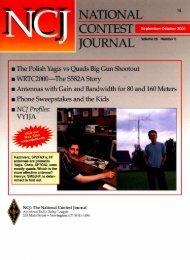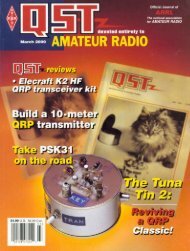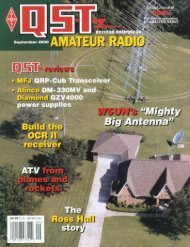It is with deep regret that we recordthe passing of these amateurs.KV1A, Kare Helberg, Norwalk, CT*W1BHZ, Thomas R. Carter, Monroe, CTKA1BRZ, Douglas N. Gianino, Meriden, CTW1CAS, Clement A. LeClair, Deland, FLWB1DKS, Richard J. Stevenson, Bangor, MEW1DNI, Vincent E. Volowski, Strong, MEW1EZR, Bernard R. Langley, Auburn, MEK1HAS, Lawrence P. Coolidge, Myrtle Beach, SCW1HCR, John F. Barrows, East Falmouth, MAW1KDW, John N. Edgerton, New Gloucester, MEKA1KQY, Lorraine S. Evans, Flagler Beach, FLW1MXT, Gerald H. Leavitt, Millinocket, MEW2AUF, David W. Winter, Woodhaven, NYW2CFU, Joseph W. Lyon, Pelham, NYK2EII, Donald W. Shanks, Blue Hill, MEW2KIJ, Joseph C. Patocka, Horseheads, NYK2LV, William J. McCarren, Bronxville, NYKJ2P, John F. Heveron, Rochester, NYWA2QQZ, Erdem Yurtseven, North Massapequa, NYK2WAK, William A. Kneaskern, Auburn, NYWA2WHU, Robert L. Mallar, Lake Ronkonkoma, NYWA2YPT, Helen A. Armstrong, Livonia, NYW2YRH, Tyler C. Stewart, Fayetteville, NY*NF2Z, Robert M. O’Connell, Rochester, NYKA2ZPL, Sheldon L. Simmons, Jamestown, NY*WA3AHK, Dave Strain, Long Beach, MSWA3LLD, Joseph C. Ankele, Lafayette Hill, PA*W3ML, George H. Reifenstein, Auke Bay, AKK3NLX, Richard H. Altenburg, Camp Hill, PAW3VR, Alfred S. Burke, Seminole, FLW3ZTM, William H. Johnson, Chestertown, MDWB4AHP, Thomas E. Riddell, Irvine, KY*K4AWY, Ralph C. Scott, Clarks Hill, SCWD4CDE, Barry L. Nadler, Sunrise, FLKF4CZ, W. H. Lewis, Cookeville, TNW4DKR, John Martin Dill, Huntingdon, TNN4ENZ, Elizabeth M. Zimmerman, Knoxville, TNK4GF, James M. Fisher, Ocala, FLKA4GMA, Wade H. Murph, Kingsport, TNK4IPG, Kenneth E. Neidig, Morristown, TNKB4L, Charles A. Adams, Clarksville, FLKA4LXI, H. G. Lissauer, Fort Lauderdale, FLW4MBN, Walter Rule, Kingsport, TNWA4MJI, Elizabeth S. Barry, Plantation, FLKQ4ND, Francis R. Geng, Jupiter, FLW4NJG, Marie K. Manthe, Port Charlotte, FLKD4NOL, Joseph D. Brooks, Morristown, TNW4PSN, Charles H. Green, Portland, TNW4PVC, Nathan Sinreich, Tamarac, FLN4PVL, William F. Potter, Fredericksburg, VAN4RJG, Hubert R. King, Albany, GASILENT KEYSKB4TB, Jack P. Thacker, Montgomery, ALWA4TNB, David E. Toms, Columbus, GAW4TOI, Ernest L. Bishop, Sheffield, ALWB4TOQ, Melvin L. Whitley, Fyffe, ALKC4XP, James D. Crossett, Nashville, TNAD4ZG, L. Mark Aceti, Punta Gorda, FLW5BDR, Edward A. Moory, De Witt, ARW5BIN, Leo Kennedy, Waco, TXW5BRT, Ralph L. Cordell, Tulsa, OKW5DS, Robert W. Edlund, Crescent, OKW5FNA, Bill Case, San Antonio, TXKC5GYG, Leo H. Arceneau, Hatfield, ARK5IQV, Joseph Domino, Houston, TXW5JT, Carleton N. Hughs, Houston, TXW5MC, Theodore W. Bywaters, Dallas, TXKB5NAF, Harold Finney, Waco, TXKA5NPY, William W. Page, Lufkin, TXW5OUJ, Albert W. Loughrige, Las Cruces, NMK5PES, David W. Rule, Albuquerque, NMKC5RD, Roderick C. Pulley, Grand Prairie, TXK5RYT, Donald E. Dingus, Lamesa, TXKB5WXU, Leon C. Rhodes, Heber Springs, ARN6ALR, Harry H. Billings, Fresno, CAKH6CCL, Ernest J. Kurlansky, Kamuela, HIW6CTS, Asel C. Briggs, Yucca Valley, CAKA6DXY, James W. Sheley, Pleasanton, CAKF6EKP, Rosemary C. Willis, Sun Valley, CAK6IIR, Wade G. Swoboda, San Diego, CAK6IVD, Leland F. Gipson, Fort Jones, CAW6MHQ, Johnny Vaucher, Dothan, ALW6MNH, Calvin L. Heisinger, Escondido, CAWA6MOZ, Elbert O. Lindley, Corona, CAK6ND, Homer H. Biedebach, Pasadena, CA*W6NZB, Arthur Lawler, La Mirada, CAWB6OSE, Michael C. Madigan, Susanville, CAWA6OSQ, Earle E. Pollock, Aptos, CAKD6OT, Paul G. Dunmire, Yuma, AZWA6OVE, Harry L. Odgers, Mariposa, CAWA6QNM, William Perry, Fresno, CAWA6RYY, Eddy T. Railey, Morgan Hill, CAW6SJZ, Kenneth W. Case, Heber Springs, ARKE6TPG, Peggy W. Locascio, Rancho PalosVerdes, CAWA6UOC, Victor M. Martin, Encino, CAK7CDX, Elmer R. Cyr, Sandy, UTWB7DLT, Jonathan K. Shafer, Tacoma, WA*W7GHO, Jack L. Carlson, Kirkland, WAW7GVC, Patrick L. Stewart, Walla Walla, WAW7HV, David L. Johnson, Seattle, WAW7ILL, Monte Norris, Big Piney, WYW7JMH, Lemuel H. Allen, Boise, IDWU7P, L. S. Preston, Shelton, WA*N7SX, Jon S. Eastman, Palmdale, CAW7UGK, La Verne Baker, Everett, WAKB7VAA, Gary Staley, Price, UTKG7YW, Jack Griffith, Battle Ground, WAKB8HNW, Dennis M. Wright, Eastlake, OHN8KAY, Richard Hunter, Big Rapids, MI*K8NFP, Rebecca B. Nathanson, FarmingtonHills, MI*K8NXN, Jarold E. Shields, Peoria, AZW8PEV, James R. Malone, Westlake, OHW8SDO, Clayton Bashford, Miamisburg, OHK8SNJ, Charles J. Oebels, Englewood, OHWA8YPT, John F. Suhadolnik, Cleveland, OHK9CZM, Lee W. Smith, Libertyville, ILKC9DI, Ralph F. Bruebach, Glenview, ILW9DOD, Vernard Rush, Lafayette, INW9ELU, Robert L. Mawdsley, Dayton, OHK9GRG, Floyd J. Brown, Hennepin, ILWB9HZV, Guinevere R. Reed, Clinton, ILKB9IFI, Dwaine H. Bell, Beloit, WIKA9LVV, Le Roy C. Swanson, Pekin, ILK9STP, Albert R. Turner, Morrison, ILWB9SVA, W. R. Jones, Monticello, INW9UCT, Forest C. Kientz, Oak Ridge, TNW0DYL, Wallace Leonard, Gladstone, MOKI0FO, Herman B. Wade, Fulton, MO*W0IHO, Arthur A. Barbeau, Colorado Springs, COW0OK, C. F. Koelsch, Saint Paul, MNK0VVW, William H. Cunniff, Aitkin, MNKB0YFU, Elizabeth V. Kennedy, Linn, MODL6ZZ, August Voss, Hamburg, GermanyVE4BJ, W. A. Stunden, Winnipeg, ON, CanadaVE7DCH, George Chase, Victoria, BC, CanadaZL2MA, Ken McGuire, Titahi Bay, New Zealand*Life Member, ARRLNote: Silent Key reports must confirm the deathby one of the following means: a letter or notefrom a family member, a copy of a newspaperobituary notice, a copy of the death certificate,or a letter from the family lawyer or the executor.Please be sure to include the amateur’sname, address and call sign. Allow severalmonths for the listing to appear in this column.Many hams remember a Silent Key with a memorialcontribution to the ARRL Foundation. If youwish to make a contribution in a friend or relative’smemory, you can designate it for an existing youthscholarship, the Jesse A. Bieberman MeritoriousMembership Fund, the Victor C. Clark Youth IncentiveProgram Fund, or the General Fund. Contributionsto the Foundation are tax-deductible tothe extent permitted under current tax law. Ouraddress is: The ARRL Foundation Inc, 225 MainSt, Newington, CT 06111.Kathy Capodicasa, N1GZO Silent Key Administrator92 <strong>May</strong> <strong>2000</strong>STRAYSWANTED: SCHEMATICS◊ I’m looking for a schematic diagram for aFordHam 550-MHz frequency counter.Please contact Daniel V. Mackey, 70 CandlewoodGardens, Baldwinsville, NY 13027-2634; KC2DCX@arrl.net.◊ I need a schematic for a RadioShack(Micronta) multimeter model 20-220A. RichardSmith, KB4OOW, 100 Elgin Hills Dr,Rogerville, AL 35652-0054◊ I’m searching for a schematic for a Tenko1210A, 2-meter FM transceiver. James Kimball,K9JXW, 602 N. 72nd Ave, Wausau, WI 54401.◊ Looking for Rohde & Schwarz receivermanualtype EK-07. Harry A. Weber, 4845West 107th St, Oak Lawn, IL 60453-5252.NEW PRODUCTSLOGWINDOWS, TNC AND WEFAXPROGRAM PACKS FROM CSS◊ Creative Services Software announces the releaseof two new “Digital Trio” CD ROMS eachcontaining three of their popular Amateur Radiosoftware products packaged on a single CD.The Trio for Kantronics TNCs includesPacterm ’98 version 1.4, Wefax ’99 version 1.01and LogWindows version 3.06.05. The Trio forAEA/Timewave TNCs includes PkTerm ’99version 1.4d, Wefax ’99 version 1.01 for the PK-232/900 and LogWindows version 3.06.05.The CD also includes complete documentation,in Word or PDF format, for all of their products,and demo versions of additional CSS softwareand supported programs.If purchased separately, the total price for thethree software titles alone would retail for over$189. The retail price for either of the Digital TrioCDs is $129.95. For additional information visityour favorite Amateur Radio products dealer orcontact Creative Services Software, 503 W StateSt, Suite 4, Muscle Shoals, AL 35661; tel 256-767-3739; fax 256-381-6121; info@cssincorp.com; http://www.cssincorp.com.
75, 50 AND 25 YEARS AGO<strong>May</strong> 1925◊ The cover, by ClydeDarr, 8ZZ, shows 8WFI“Sending Pictures byAmateur Radio.” Theeditorial’s first subject,“Local Vigilance Committee,”tells how theTraffic Department isforming local hams intocommittees to deal withthe increasing problem ofham interference tobroadcast listeners. Theeditorial also reports on“The I.A.R.U. Congress,” which will be conveningas the issue goes to press, commenting that “… thetime has arrived when the two-way telegraphers andexperimenters actually need organization and coordination.”Frank Jones, 6AJF-6XM, describes the “PioneerShort-Wave Work” done by three California hams,telling how they experimented to determine theproper length of “reflector wires”, arranged in aparabolic arc behind the sending set’s antenna atwavelengths below 3 meters, to produce strongersignals. Various results are noted, some of whichcan be explained, and others, not. Dan Wilkersondiscusses “Visible Radio Communication,” describingthe “Jenkins Duplex Photogram Machine” andtelling how the “automatic facsimile machine” cantransmit and receive pictures via radio. ByronMinnium describes “The Isofarad Receiver.” “SendingLicenses Suspended” reports that about 100hams’ licenses have been suspended for violationof the new radio rules! “Amateur Radio at FloydCollins’ Cave” tells how ham radio helped get thenews of Collins’ entrapment in a Kentucky cave tothe outside world. 9BRK and 9CHK manned a portablestation near the cave and relayed reports tothe nearest telegraph line, several miles away. The“Experimenters Section Report” tells how an experimentaltransmitter was operated at a wavelengthof 3 /4 meter, and solicits suggestions for further experimentsfrom <strong>QST</strong> readers. William Murphy tellsof his experiments with “Top-Loading Antennas andLoops.”<strong>May</strong> 1950◊ The cover photo showsa compact amplifier for10, 6 and 2 meters, describedin this issue, thatuses a pair of 826 tubes.The editorial is a rareguest editorial written byFrank Fisher, W5AHT.His argument in supportof organized Amateur Radioleads the editor tocomment, “We wish wehad written it!”By Goodman, W1DX, tells about “A Variable-Selectivity Sharp I.F. Amplifier,” to be used as “anoutrigger ‘Q10-er’ for the C.W. man.” Charles Dene,W3CPC, presents “A Low-Cost TVI filter.” In “‘TailorMade’ Antenna Couplers,” George Grammer,W1DF, tells about optimum designs using new commerciallymade coils. Richard Smith, W1FTX, discusses“Utilizing the 826” in his compact 250-Wamplifier for 10, 6 and 2 meters. Louis Hippe,W6APQ, writes about “Tower and Rotator Techniques,”with Part I telling how to build a ruggedwooden tower. The final ’phone results for the “16thSweepstakes Contest” report that three hams brokethe 100,000 point barrier for the first time—W6OGZ (with the top SS phone score of 122,400points), W6ITH and W6QEU. The fourth-placescore was W7PUM’s 75,641 points, to put those sixdigitscores in perspective. Henry Hayes, W3JUM,writes about “A Compact 2-Meter Station for MobileUse.” “Future-hamic,” by Kermit Slobb,W9YMZ, imagines a two-way amateur televisioncontact in the future year of 1980.<strong>May</strong> 1975◊ The cover photo shows Amateur Radio aidingeducation in Scotland. The editorial discusses thecurrent chore of tallyingthe results of the recentmembership questionnaire,noting the trend towardthe fragmentationwithin Amateur Radiothat sometimes worksagainst the united frontthat we must present toexternal organizations.Steve Gross, W9OJI,describes “A Parallel-4CX250B Amplifier for144 MHz.” In “The CitySlicker,” under the “Beginnerand Novice” banner, Milton Drake, W2JPN,tells about his simple inductive loading system forusing an 8-foot whip on the HF bands. [Coincidentally,Sam Harris, W8UKS, used “The City Slicker”as the name for his stack of four folded 144 MHzdipoles in his November 1949 <strong>QST</strong> article.—Ed.]John Kaufmann, WA1CQW, and Gary Kopec,WA8WNU, tell about “A Convenient Stub-TuningSystem for Quad Antennas.” Parts II are presentedin the two series “Learning to Work with Semiconductors,”by Doug DeMaw, W1CER, and JayRusgrove, WA1LNQ; and “Slow-Scan to Fast-ScanTV Converter,” by George Steber, WB9LVI. Thecover story, “Amateur Radio Boosts Education,”by Barbara Dirrigl, tells how schools in Scotlandare using OSCAR satellites to further classroomstudies. “Fifi vs. Honduras” reports amateur emergencycommunication work in Honduras followinghurricane Fifi. “Results, 41st ARRL NovemberSweepstakes” reports that, once again, there werea record number of participants—2425 entries. Onenotable entry was WB8OFR, who placed first onphone and second on CW from the competitiveOhio Section, using Drake-line gear and dipoles.Nothing special, you might think—but Frank isblind! The close contest in the affiliated club scoresfound the Potomac Valley Radio Club barely beatingout Murphy’s Marauders, 8,570,392 to8,488,980.—Al Brogdon, W1ABW1AW SCHEDULEPacific Mtn Cent East Mon Tue Wed Thu Fri6 AM 7 AM 8 AM 9 AM Fast Slow Fast SlowCode Code Code Code7 AM- 8 AM- 9 AM- 10 AM-Visiting Visiting Operator Time1 PM 2 PM 3 PM 4 PM (12 PM - 1 PM Time closed for lunch)1 PM 2 PM 3 PM 4 PM Fast Slow Fast Slow FastCode Code Code Code Code2 PM 3 PM 4 PM 5 PM Code Bulletin3 PM 4 PM 5 PM 6 PM Teleprinter Bulletin4 PM 5 PM 6 PM 7 PM Slow Fast Slow Fast SlowCode Code Code Code Code5 PM 6 PM 7 PM 8 PM Code Bulletin6 PM 7 PM 8 PM 9 PM Teleprinter Bulletin6 45 PM 7 45 PM 8 45 PM 9 45 PM Voice Bulletin7 PM 8 PM 9 PM 10 PM Fast Slow Fast Slow FastCode Code Code Code Code8 PM 9 PM 10 PM 11 PM Code BulletinW1AW’s schedule is at the same local time throughout the year. The scheduleaccording to your local time will change if your local time does not have seasonaladjustments that are made at the same time as North American timechanges between standard time and daylight time. From the first Sunday inApril to the last Sunday in October, UTC = Eastern Time + 4 hours. For the restof the year, UTC = Eastern Time + 5 hours. Morse code transmissions:Frequencies are 1.818, 3.5815, 7.0475, 14.0475, 18.0975, 21.0675, 28.0675and 147.555 MHz.Slow Code = practice sent at 5, 7 1 /2, 10, 13 and 15 wpm.Fast Code = practice sent at 35, 30, 25, 20, 15, 13 and 10 wpm.Code practice text is from the pages of <strong>QST</strong>. The source is given at the beginningof each practice session and alternate speeds within each session. For example,“Text is from July 1992 <strong>QST</strong>, pages 9 and 81,” indicates that the plain text is fromthe article on page 9 and mixed number/letter groups are from page 81.Code bulletins are sent at 18 wpm.W1AW qualifying runs are sent on the same frequencies as the Morse codetransmissions. West Coast qualifying runs are transmitted on approximately3.590 MHz by K6YR. At the beginning of each code practice session, theschedule for the next qualifying run is presented. Underline one minute of thehighest speed you copied, certify that your copy was made without aid, andsend it to ARRL for grading. Please include your name, call sign (if any) andcomplete mailing address. Send a 9×12-inch SASE for a certificate, or a business-sizeSASE for an endorsement. Teleprinter transmissions:Frequencies are 3.625, 7.095, 14.095, 18.1025, 21.095, 28.095 and147.555 MHz.Bulletins are sent at 45.45-baud Baudot and 100-baud AMTOR, FEC Mode B.110-baud ASCII will be sent only as time allows.On Tuesdays and Fridays at 6:30 PM Eastern Time, Keplerian elements formany amateur satellites are sent on the regular teleprinter frequencies. Voice transmissions:Frequencies are 1.855, 3.99, 7.29, 14.29, 18.16, 21.39, 28.59 and147.555 MHz. Miscellanea:On Fridays, UTC, a DX bulletin replaces the regular bulletins.W1AW is open to visitors from 10 AM until noon and from 1 PM until 3:45 PMon Monday through Friday. FCC licensed amateurs may operate the stationduring that time. Be sure to bring your current FCC amateur license or aphotocopy.In a communication emergency, monitor W1AW for special bulletins as follows:voice on the hour, teleprinter at 15 minutes past the hour, and CW on thehalf hour.Headquarters and W1AW are closed on New Year’s Day, President’s Day,Good Friday, Memorial Day, Independence Day, Labor Day, Thanksgivingand the following Friday, and Christmas Day. 3/00<strong>May</strong> <strong>2000</strong> 93
- Page 6 and 7:
May 2000 Volume 84 Number 5David S
- Page 11 and 12:
THE AMERICAN RADIORELAY LEAGUE INC
- Page 14:
Get to Know Your Section ManagerThe
- Page 18:
The ARRL and the FCC’s Private Wi
- Page 22 and 23:
The postman always keys twice.Accor
- Page 26 and 27:
CORRESPONDENCEYour opinions count!
- Page 30 and 31:
By Ian Poole, G3YWXOperating in the
- Page 32 and 33:
By Roger Sullivan, WA0ETE, and Hugh
- Page 34 and 35:
By Jim Graver, KB8PSO2000Dayton Ham
- Page 36 and 37:
Figure 1A—Schematic of the interf
- Page 38 and 39:
All input/output connections are ma
- Page 40 and 41:
Figure 4—Hanger loopconstruction.
- Page 42 and 43:
Figure 2—A GOES-8 picture capture
- Page 44 and 45: By Steve Ford, WB8IMYPSK31 2000In e
- Page 46 and 47: the software, PSK31 tuning required
- Page 48 and 49: WORKBENCHPROJECTS AND INFORMATION F
- Page 50 and 51: By Martin A. Minow, K6MAMPractice M
- Page 52 and 53: the download to a suitable location
- Page 54 and 55: 52 May 2000SHORT TAKESHeil Sound Go
- Page 56 and 57: By Zack Lau, W1VTA No-Tune 2-Meter
- Page 58 and 59: HINTS & KINKSA FOLD-DOWN MOBILE-ANT
- Page 60 and 61: By James Kates, N9GBBConfessions of
- Page 62 and 63: PRODUCT REVIEWKenwood TM-D700A Dual
- Page 64 and 65: is accomplished by using OK, BACK a
- Page 66 and 67: other radio operation. The chatter
- Page 68 and 69: operation because there’s so litt
- Page 70 and 71: consideration in the WT Docket 98-1
- Page 72 and 73: News in Brief:• League members no
- Page 74 and 75: communications tests in celebration
- Page 76 and 77: I’ve done this tour several years
- Page 78 and 79: The Crystal Symphony at anchor off
- Page 80 and 81: Table 1Claimed North American Dista
- Page 82 and 83: Okay in My LogBy Vic Curtis,WA3YUVP
- Page 84 and 85: their 432 MHz triumph of the previo
- Page 86 and 87: 2000 ARRL Field DayRulesBy Dan Hend
- Page 88 and 89: Collecting Vintage QSLsOLD RADIOAn
- Page 90 and 91: DIGITAL DIMENSIONAPRS Digipeater in
- Page 92 and 93: AT THE FOUNDATIONWhy We Fund Museum
- Page 96 and 97: COMING CONVENTIONSARRL NATIONAL CON
- Page 98 and 99: checking; handicapped accessible; f
- Page 106: of the West Allis ARC and served as
- Page 110: introduced that could of had a bear
- Page 114: 211/109; NJN/L 29/203/103; CJTN 29/
- Page 118: W1PEX 1048, WA1JVV 143, N1NH 105, W
- Page 124: an activity we enjoy so much can be
- Page 128: 126He is President of the Amateur R
- Page 132: is Walt Bacon, N6SMT, who is curren
- Page 150:
Ham Adsl) Advertising must pertain
- Page 154:
BAHAMAS RENTAL: Abaco villa w/stati
- Page 164:
“EVERYTHING FOR THE MORSE ENTHUSI
- Page 168:
TUBES WANTED: Highest prices paid o
















